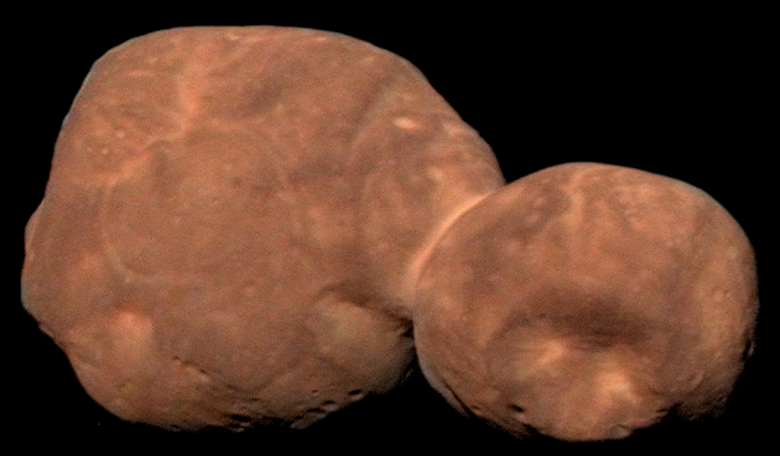Data gathered in recent flyby’s of Arrokoth, the bi-lobed, red, peanut-like object located one billion miles beyond Pluto in the Kuiper belt, is helping scientists to make significant advances in understanding how planets and planetesimals – the building blocks of the planets – were formed.
After a decade-long journey, traveling 3.26 billion miles (5.25 billion kilometers) across our solar system, NASA’s New Horizons spacecraft flew past Pluto and its five moons to give scientists an unprecedented view of this remarkable frozen world and its satellites.
The flyby was the first exploration of a world so far from Earth and with its prime mission now accomplished, New Horizons moved onto its next target; an odd-ball of an object which initially appeared to be two flattened disks joined together after slamming into one another.
Officially renamed from Ultima Thule to Arrokoth, a Native American term that means "sky" in the Powhatan/Algonquin language, this 35 kilometre (22 mile) long body turned out to look very different when New Horizons passed within a paltry 3,500 kilometers (2,200 miles) from the object at the start of 2019.
Instead of being flat, Arrokoth turned out to be a puffed-out, eerie-looking rounded snowman with hollowed out-eyes and a frown for a mouth when viewed at a certain angle. It was a shape unlike anything else seen in the Solar System so far.
Already suspected to be untouched for billions of years, its shape, colouring and notable smooth surface offered researchers the clearest look back to the earliest stages of planetary formation and now that a bulk-load of data collected in the flyby has been analysed, the latest scientific findings on the object haven’t disappointed.
“Arrokoth is the most distant, most primitive and most pristine object ever explored by spacecraft, so we knew it would have a unique story to tell,” said New Horizons Principal Investigator Alan Stern, of the Southwest Research Institute in Boulder, Colorado.
Those results are detailed in three separate studies by three different teams, all published in Science, and when viewed collectively they have helped to paint a uniformed view of Arrokoth.
In the first study, William McKinnon, a New Horizons co-investigator from Washington University in St. Louis and colleagues used simulations to better understand how Arrokoth formed. Their results suggests that the two lobes of the binary object were previously independent bodies formed close together, and after a very gentle bump became stuck together.
Meanwhile, while investigating Arrokoth’s smooth, lightly cratered surface, John Spencer, a project scientist on New Horizons based at Southwest Research Institute (SwRI) in Boulder, Colorado and his colleagues suggest in their report that the relative lack of impacts on the object’s body crater infers Arrokoth has a surface age of about 4 billion years.
Finally, Will Grundy,New Horizons composition theme team lead from Lowell Observatory in Flagstaff, Arizona and colleagues have found that Arrokoth’s uniformly red, cold, surface is covered with methanol ice and unidentified complex organic molecules.
Although water was not detected on Arrokoth, Grundy and colleagues offer several suggestions as to how methanol could have formed on this object, including formation by cosmic ray irradiation of mixed water and methane ices
Despite the individual nature of each study, there was one recurring, underlying feature that lead them all to the same conclusion; Arrokoth looks and behaves the way it does because it formed in a local collapse cloud of the solar nebula.
This is far removed from the other alternative longstanding theory of planetesimal formation, whereby objects from disparate parts of the nebula collided to form the object; a process called hierarchical accretion.
“Arrokoth has the physical features of a body that came together slowly, with ‘local’ materials in the solar nebula,” says Grundy. “An object like Arrokoth wouldn’t have formed, or look the way it does, in a more chaotic accretion environment.”
It’s teaching us how planetesimals formed, said Stern at a media briefing 13 Feb at the annual American Association for the Advancement of Science meeting in Seattle.
“All of the evidence we’ve found points to particle-cloud collapse models, and all but rule out hierarchical accretion for the formation mode of Arrokoth, and by inference, other planetesimals,” Stern said.
This marks a “significant advance in understanding overall planetesimal and planet formation” he concluded.











